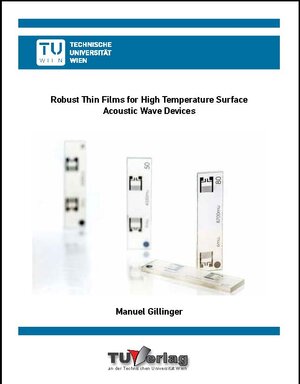
×
![Buchcover ISBN 9783903024656]()
Robust Thin Films for High Temperature AcousticWave Devices
von Manuel GillingerAbstract
Surface Acoustic Wave (SAW) devices are nowadays most commonly used in the tele-communication sector as frequency filters or as delay lines. Besides these standard applications, such devices can also be used as key components in battery-less and wireless sensor applications. This may include temperature measurements, both in high temperature as well as aggressive gaseous environments.
Current solutions for high temperature stable SAW devices are based on substrates like langasite, langatate or langanite. The main disadvantage of all these crystals is the low phase velocity (~2700 m/s) and the high transition losses of the signal at elevated temperatures. To overcome these drawbacks, sputter deposited piezoelectric aluminum nitride (AlN) thin films in combination with sapphire as substrate are a promising alternative. Phase velocities of around 5700 m/s can be reached, which is substantially higher compared to the aforementioned material systems. Therefore, higher resonance frequencies can be achieved with the same device geometry.
In this thesis, the impact of temperature as well as inert and aggressive gas atmospheres on the electro-mechanical properties of aluminum nitride thin films are investigated. In addition to the material science analysis, SAW devices based on aluminum nitride on sapphire substrates were fabricated. To achieve a better understanding of the device characteristics, the thickness of the piezoelectric layer and the wave propagation direction with respect to the crystallographic orientation of the sapphire substrate were varied systematically. Finally, SAW devices were measured during high temperature loads up to 800 °C in an inert gas atmosphere and the impact on device performance was evaluated.
Surface Acoustic Wave (SAW) devices are nowadays most commonly used in the tele-communication sector as frequency filters or as delay lines. Besides these standard applications, such devices can also be used as key components in battery-less and wireless sensor applications. This may include temperature measurements, both in high temperature as well as aggressive gaseous environments.
Current solutions for high temperature stable SAW devices are based on substrates like langasite, langatate or langanite. The main disadvantage of all these crystals is the low phase velocity (~2700 m/s) and the high transition losses of the signal at elevated temperatures. To overcome these drawbacks, sputter deposited piezoelectric aluminum nitride (AlN) thin films in combination with sapphire as substrate are a promising alternative. Phase velocities of around 5700 m/s can be reached, which is substantially higher compared to the aforementioned material systems. Therefore, higher resonance frequencies can be achieved with the same device geometry.
In this thesis, the impact of temperature as well as inert and aggressive gas atmospheres on the electro-mechanical properties of aluminum nitride thin films are investigated. In addition to the material science analysis, SAW devices based on aluminum nitride on sapphire substrates were fabricated. To achieve a better understanding of the device characteristics, the thickness of the piezoelectric layer and the wave propagation direction with respect to the crystallographic orientation of the sapphire substrate were varied systematically. Finally, SAW devices were measured during high temperature loads up to 800 °C in an inert gas atmosphere and the impact on device performance was evaluated.


